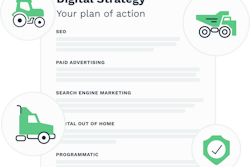
MEMA’s Heavy Duty Manufacturers Representative Council turned its eye to offshore components on Thursday, presenting the results of a survey of dealers and distributors in a webinar.
Led by Philip Atkins, MEMA’s director of strategic research and planning, and Lucas Deal, Trucks, Parts, Service chief editor and content director, the panel also featured Ryan Stronk, president of Western States Marketing, and Don Gritzmacher, president of Enders & Associates.
[RELATED: MEMA announces speakers for commercial vehicle outlook conference]
Offshore suppliers, in this case, refer to companies headquartered outside of North America. According to MEMA’s respondents, most of them have noticed more offshore suppliers in the marketplace. Atkins says the response confirms the council’s hypothesis, and Gritzmacher says there’s definitely an uptick since the supply chain upheaval from the COVID pandemic.
But not all offshore companies are created equal.
“I’m not so convinced they’re all clear with their go-to-market strategy yet,” Gritzmacher says. Before choosing to represent an offshore supplier, Gritzmacher and Stronk both say their companies go through a process to ensure end customers in the North American market are getting a quality product. That involves field testing, sampling and on-site evaluations.
“There’s a bit of a process we go through,” Gritzmacher says.
Neither executive sees offshoring tapering off either. The freight recession is giving fleets and other customers reason to look for a price point when it comes to components. That’s also affecting margins for dealers and distributors. Both segments reported a negative effect on profitability from offshore components. A little more than half, 52%, of distributors and 59% of dealers reported negative effects on profitability.
“When you look at profitability, let’s be honest, the dealers support their corporate entities first,” Gritzmacher says. “The corporate entities these dealers are tied to have been a little slower in adopting these vendors that are offshore.”
There is an upside of lower prices and margins. Both distributors and dealers report more access to customers and markets with offshore components.
“The offshoring allowed them to tackle more price-conscious customers,” Atkins says.
Stronk says there are two types of distributors, those with price-sensitive customers and those with customers who expect a higher-end product. Those with price-sensitive customers are more likely to take advantage of the lower price points on an offshore product. Other distributors may elect to use mostly domestic products, but use offshore products to fill in gaps in their coverage or for products that aren’t mission-critical.
“They’re relying on an overseas part or component to complement, not replace, OEM or domestic suppliers,” Stronk says. “It’s helping with a couple things. It’s filling gaps in availability, it’s helping serve a price-sensitive customer.”
And that may be because distributors and dealers view offshore components as lower quality than domestic components. The survey showed 75% of distributors and 63% of dealers believe offshore quality is significantly or slightly lower than domestic products, with a few respondents saying it was about the same.
“There’s no one saying the quality is better than domestic suppliers,” Atkins says.
That’s not for lack of trying, in some cases. Both Stronk and Gritzmacher say there are offshore companies manufacturing a quality product that can challenge domestic or OEM components. But because there are companies that aren’t producing the best product they can, and those taint the water.
“We certainly listen to the customer,” Gritzmacher says. “From a liability standpoint, we’re just as concerned as they are.”
Even though price is top of mind right now, there are some other factors to consider. Stronk and Gritzmacher say domestic manufacturers can fight back with their own value lines and be willing to reinvent themselves. They also encourage suppliers to create value through training and product information.
“That really does set you apart,” Stronk says. “Any time you can make your customer a better professional, there’s a perceived value there.”











